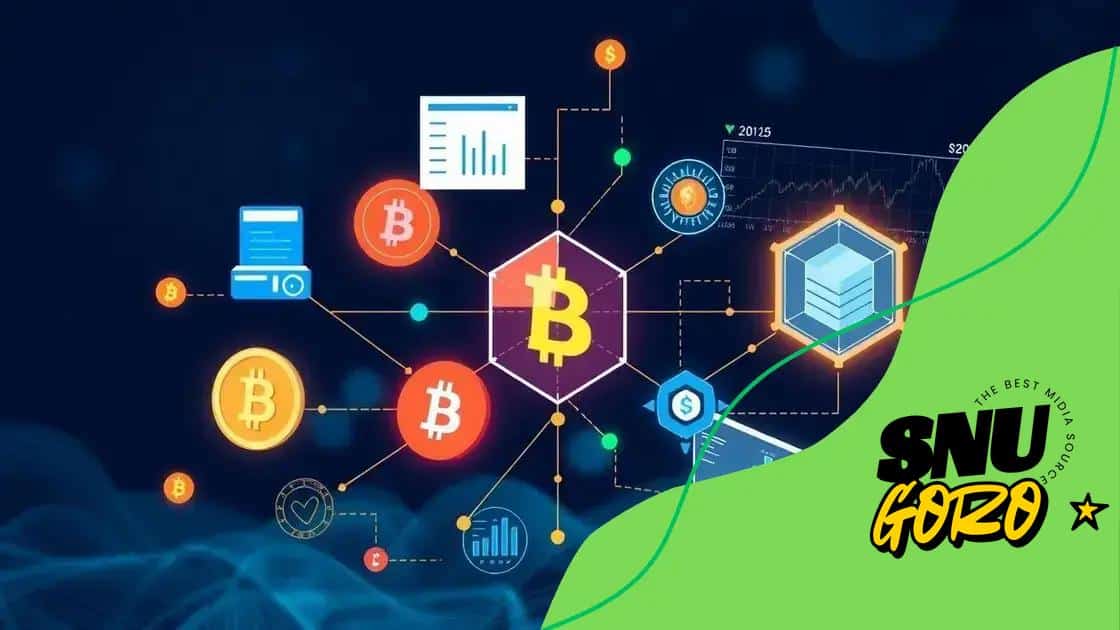How blockchain is transforming the stock trading landscape

Blockchain is transforming the stock trading landscape by enhancing efficiency, security, and transparency while introducing challenges like scalability and regulatory uncertainty, with emerging trends such as AI integration and decentralized finance shaping the future.
How blockchain is transforming the stock trading landscape opens up exciting possibilities for both investors and traders. Have you considered how this technology reshapes market operations and increases transparency?
Understanding blockchain technology
To grasp how blockchain works, it’s essential to look at its core principles. Blockchain technology is a decentralized digital ledger that securely records transactions across many computers. This setup prevents data alteration, ensuring transparency and reliability.
How does blockchain function? The technology relies on a network of computers, known as nodes, that validate and record transactions. Each transaction is stored in a block, and these blocks connect in chronological order, creating a chain. Because everyone in the network has access to the same record, trust among participants is enhanced.
Key Features of Blockchain Technology
Understanding the key features of blockchain can help you appreciate its benefits:
- Decentralization: No single entity controls the entire network, making it less vulnerable to failures.
- Immutability: Once a transaction is recorded, it cannot be changed, ensuring data integrity.
- Transparency: All participants have access to the same data, fostering trust between users.
The evolution of blockchain has led to numerous applications beyond cryptocurrency. Industries are now exploring how this technology can improve processes and increase security. For instance, in stock trading, the efficiency gains from using blockchain can significantly enhance transaction speeds and reduce costs.
Using blockchain in trading also minimizes fraud and enhances compliance with regulations. By verifying transactions through a consensus mechanism, blockchain provides a reliable method of ensuring validity and accuracy. This shift holds the potential for major disruptions in how financial assets are traded.
With the rise of decentralized finance (DeFi), blockchain’s impact is expanding rapidly. DeFi platforms aim to replicate traditional financial services, such as lending and borrowing, using smart contracts on the blockchain, which enables trustless transactions without intermediaries.
As blockchain continues to evolve, understanding its nuances becomes increasingly important. Embracing this technology opens up new avenues for innovation and efficiency in various sectors, particularly in finance. The way we view and conduct stock trading may never be the same.
Key benefits for stock trading
Implementing blockchain technology brings several key benefits for stock trading. These advantages offer traders and investors innovative solutions to traditional challenges. One major benefit is increased transparency in transactions, which fosters trust among users and enhances market integrity.
How does blockchain enhance efficiency? The decentralized nature of blockchain allows for faster transaction processing. When trades occur, they can be recorded in real-time, reducing the time it takes for settlements.
Advantages of Using Blockchain in Stock Trading
Several specific benefits of blockchain technology for stock trading include:
- Reduced Costs: By eliminating intermediaries, transaction fees can be dramatically lowered, making trading more accessible.
- Enhanced Security: Blockchain employs strong cryptographic techniques, ensuring that transaction data is secure from fraud and cyber attacks.
- Improved Liquidity: With faster trading and settlement processes, liquidity in the market is enhanced, allowing investors to act quickly.
Another significant aspect is the ability to conduct trades without needing a central clearinghouse. This independence leads to lower reliance on traditional financial institutions, which can often be slow and cumbersome. By removing these intermediaries, traders benefit from greater autonomy over their investments.
Using smart contracts, transactions can also be automated, further streamlining operations. This reduces the potential for human error and strengthens the execution of trades under predefined conditions. The ability to implement automated trades means investors can act on market changes much faster.
Additionally, blockchain technology fosters innovation by allowing new financial products to emerge. This flexibility can lead to the development of unique trading strategies and investment vehicles, meeting diverse market needs. With these advantages combined, blockchain is steadily transforming the stock trading landscape.
Real-world applications in trading

Exploring real-world applications in trading shows how blockchain technology is altering the financial landscape. Businesses and investors alike are discovering innovative ways to leverage blockchain for various trading needs.
One major application is in the realm of cryptocurrency trading. Platforms like Binance and Coinbase use blockchain to facilitate fast and secure trades. This allows users to buy or sell cryptocurrencies without delays, making the process more efficient.
Examples of Blockchain in Trading
Several companies have adopted blockchain technology for their trading operations:
- Provenance: This platform allows companies to trace the origin of products, enhancing supply chain transparency.
- Symbiont: They provide a platform for issuing and trading financial instruments on blockchain, which improves liquidity and lowers costs.
- OpenFinance: This platform focuses on compliant trading of digital securities, allowing investors to trade assets with increased security.
Alongside cryptocurrencies, stock trading is also seeing significant shifts due to blockchain. Companies like Overstock have started offering shares on blockchain, allowing faster settlements and reduced costs. This change could redefine how stocks are traded and owned. By using blockchain, traders can access real-time information and analytics, leading to improved decision-making.
Moreover, decentralized finance (DeFi) is emerging as a revolutionary application of blockchain in trading. DeFi platforms allow users to engage in lending, borrowing, and trading without traditional intermediaries, using smart contracts to automate processes. This approach increases accessibility to financial services for users worldwide.
As more businesses recognize the benefits of blockchain, its applications in trading will continue to grow. The real-world impacts of this technology make it an essential component of the modern trading landscape.
Challenges and limitations of blockchain
While blockchain technology offers numerous advantages, there are also several challenges and limitations of blockchain that must be considered. Understanding these issues is crucial for anyone looking to implement or invest in blockchain solutions.
One significant challenge is the scalability of blockchain networks. As more users join the network, the system can become slower. For example, Bitcoin and Ethereum often face delays during peak transaction times, making it hard for users to conduct trades quickly. These scalability issues can affect user experience and hinder adoption.
Other Key Challenges
Alongside scalability, several other limitations exist:
- Energy consumption: The mining process for cryptocurrencies requires vast amounts of energy, raising environmental concerns.
- Regulatory uncertainty: Governments are still grappling with how to regulate blockchain and cryptocurrencies, which can lead to instability in the market.
- Security risks: Although blockchain is secure, it is not entirely immune to hacks and vulnerabilities, especially in poorly designed applications.
Moreover, blockchain technology can also suffer from a lack of interoperability between different blockchain platforms. This disconnection makes it difficult for users to transfer assets or information across various systems. Without suitable solutions, it can limit the overall effectiveness of blockchain technology.
Another crucial limitation is the barrier to entry for some users. The complexity of blockchain technology can be daunting, particularly for those without tech backgrounds. This intimidation can prevent wider adoption, as potential users may feel overwhelmed by the advanced features and requirements of blockchain systems.
Despite these challenges, ongoing research and development aim to address the limitations of blockchain. New consensus mechanisms and cross-chain solutions are being developed to improve scalability and interoperability. By tackling these issues, the potential of blockchain technology can be fully realized in various industries.
Future trends in stock trading
As technology evolves, recognizing future trends in stock trading is essential for investors and traders. These trends are reshaping how financial markets operate and will continue to influence trading strategies.
One emerging trend is the integration of artificial intelligence (AI) in trading platforms. AI algorithms analyze vast amounts of data to make informed trading decisions. This technology can execute trades faster than humans and improve accuracy by identifying patterns that may be missed. As a result, trading will become more efficient and potentially more profitable.
Key Future Trends
Several key trends are shaping the future of stock trading:
- Increased Automation: Many trading processes will be automated, allowing traders to focus on strategy rather than execution.
- Rise of Decentralized Finance (DeFi): DeFi platforms are changing how financial services are accessed, removing intermediaries and offering new ways to trade and invest.
- Improved Data Analytics: Advanced analytics tools will provide traders with deeper insights, allowing for better decision-making based on real-time market data.
Another significant change is the growing popularity of social trading. This approach allows investors to copy the trades of successful traders, making investing more accessible. Platforms that enable social trading are expanding, creating communities where traders can share strategies and tips. This trend democratizes access to trading insights, encouraging new investors to participate in the markets.
Moreover, the impact of blockchain technology will continue to influence trading in the future. As more companies adopt blockchain solutions, traders will benefit from increased transparency and security. This technology also allows for faster settlement times, enhancing the overall efficiency of trading operations.
Finally, the increasing focus on sustainability will define future trading trends. Investors are becoming more aware of environmental, social, and governance (ESG) factors, influencing their investment decisions. Sustainable investing will likely gain further traction, as financial markets adjust to evolving consumer preferences.
FAQ – Frequently Asked Questions about Blockchain and Stock Trading
What are the main advantages of using blockchain in stock trading?
Blockchain offers increased efficiency, security, and transparency in transactions, which helps build trust among investors.
What challenges does blockchain technology face in trading?
Blockchain faces issues like scalability, regulatory uncertainty, and energy consumption related to mining.
How is AI impacting stock trading?
AI enhances trading by analyzing large datasets quickly and accurately, enabling more informed and faster decision-making.
What are future trends to watch for in stock trading?
Key future trends include the rise of decentralized finance, increased automation, and a greater focus on sustainable investing.





